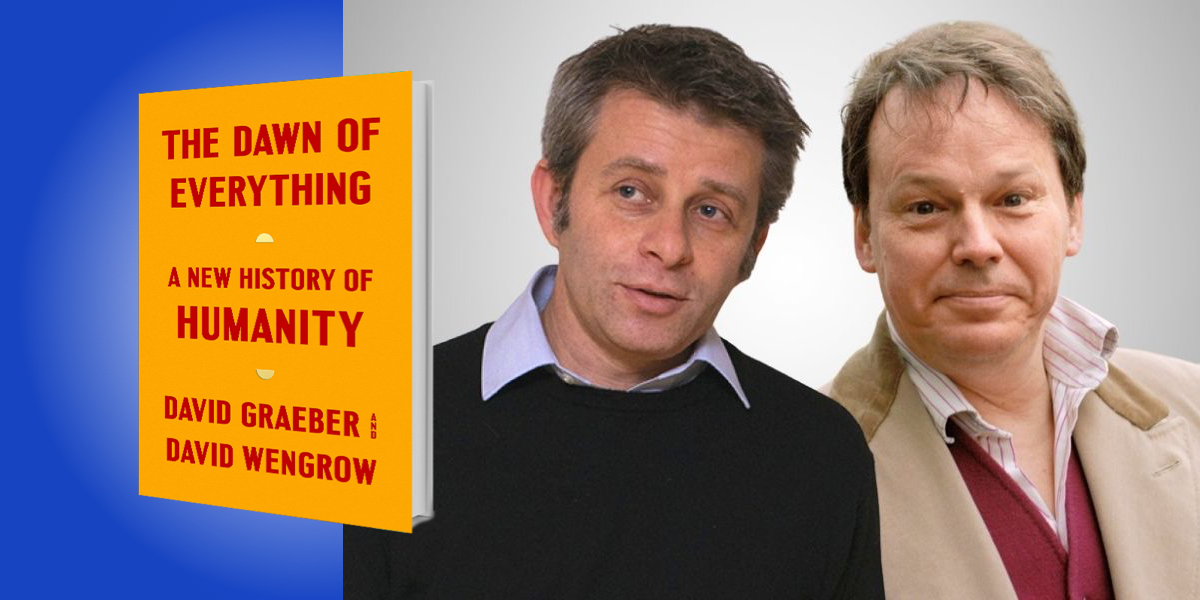David Graeber was a professor of anthropology at the London School of Economics, an organizer of Occupy Wall Street, and the author of the bestsellers Debt: The First 5,000 Years and Bullshit Jobs: A Theory. He died suddenly in September 2020, just a few weeks after finishing The Dawn of Everything. His co-author, David Wengrow, is a professor of archaeology at University College London who has conducted fieldwork throughout Africa and the Middle East.
Below, Wengrow shares 5 key insights from their new book, The Dawn of Everything: A New History of Humanity. Listen to the audio version—read by Wengrow himself—in the Next Big Idea App.
1. It’s time for a new history of humankind.
In this book, we present a new history of humankind and invite the reader into a new science of history, one that restores our ancestors to their full humanity. Rather than asking how we ended up unequal, we start by asking how inequality became such an issue to begin with. Then, gradually, we build up an alternative narrative that corresponds more closely to our current state of knowledge.
If humans did not spend 95 percent of their evolutionary past in tiny bands of hunter-gatherers, what were they doing all that time? If agriculture and cities did not mean a plunge into hierarchy and domination, then what did they imply? What was really happening in those periods we usually see as marking the emergence of the state?
The answers are often unexpected, and they suggest that the course of human history may be less set in stone—and more full of playful possibilities—than we tend to assume.
“The course of human history may be less set in stone—and more full of playful possibilities—than we tend to assume.”
2. Look past the myths.
For far too long, we have been generating myths. As a result, we’ve been mostly asking the wrong questions: Were our earliest ancestors simple and egalitarian, or complex and stratified? Is human nature innocent or corrupt? Are we as a species inherently cooperative or competitive, kind or selfish, good or evil? Perhaps all these questions blind us to what really makes us human in the first place, which is our capacity, as moral and social beings, to negotiate between such alternatives.
We no longer have to choose between an egalitarian or hierarchical start to the human story. Let us bid farewell to the childhood of man, and acknowledge that our early ancestors were not just our cognitive equals, but our intellectual peers, too. Likely as not, they grappled with the paradoxes of social order and creativity just as much as we do and understood them just as much, which also means just as little. They were perhaps more aware of some things and less aware of others. They were neither ignorant savages nor wise sons and daughters of nature.
Be that as it may, it’s becoming increasingly clear that the earliest known evidence of human social life resembles a carnival parade of political forms far more than it does the drab abstractions of evolutionary theory.
If there is a riddle here, it’s this: Why, after millennia of constructing and disassembling forms of hierarchy, did homo sapiens, supposedly the wisest of apes, allow permanent and intractable systems of inequality to take root? Was this really a consequence of adopting agriculture, of settling down in permanent villages, and later towns? Should we be looking for a moment in time, like the one that Jean-Jacques Rousseau envisaged, when somebody first enclosed attractive land, declaring, “This is mine and always will be”? Or is that another fool’s errand?
“Our early ancestors were not just our cognitive equals, but our intellectual peers, too.”
3. Cities have been around longer than we think.
The remote history of the countries around the Black Sea is awash with gold—at least, any casual visitor to the major museums of Sofia, Kyiv, or Tbilisi would be forgiven for leaving with this impression. Ever since the days of Herodotus, outsiders to the region have come home full of lurid tales about the lavish funerals of warrior kings, and the mass slaughter of horses and retainers that accompanied them. Over a thousand years later, in the 10th century AD, the traveler Ibn Fadlan was telling almost identical stories to impress and titillate his Arab region.
As a result, in these lands, the term “pre-history,” or sometimes “proto-history,” has always evoked the legacy of aristocratic tribes and lavish tombs crammed with treasure. And such tombs are certainly there to be found. On the region’s western flank, in Bulgaria, they begin with the gold-soaked cemetery of Varna, oddly placed in what regional archaeologists refer to as the Copper Age, corresponding to the fifth millennium BC. To the east, in southernmost Russia, a tradition of extravagant funeral rights began shortly after, associated with the burial mounds known as kurgans, which do indeed mark the resting places of warrior princes of one sort or another.
But it turns out this wasn’t the whole story. Magnificent warrior tombs might not even be the most interesting aspect of the region’s pre-history. There were also cities.
Archaeologists in Ukraine and Moldova got their first inkling of them in the 1970s, when they began to detect the existence of human settlements older and much larger than anything they’d previously encountered. Further research showed that these settlements, often referred to as “mega-sites,” dated to the early and middle centuries of the fourth millennium BC, which meant that some existed even before the earliest known cities in Mesopotamia.
“Magnificent warrior tombs might not even be the most interesting aspect of the region’s pre-history.”
4. The true history of civilization is only just starting to be written.
There is something odd about the way we use the term “civilization” today. When people talk about early civilizations, they mostly refer to societies like Pharaonic Egypt, Inca Peru, Aztec Mexico, Han China, Imperial Rome, Ancient Greece, or others of a certain scale and monumentality. All these were deeply stratified societies, held together by authoritarian governments, violence, and the radical subordination of women. Is it any wonder, then, that in some circles, the very idea of “civilization” has fallen into disrepute?
Something very basic has gone wrong here. One problem is that we’ve come to assume that civilization refers, in origin, simply to the habit of living in cities. Cities, in turn, were thought to imply states, but this is not the case historically or even etymologically. The word “civilization” derives from the Latin civilis, which actually refers to those qualities of political wisdom and mutual aid that permit societies to organize themselves through voluntary coalition. In other words, it originally meant the type of qualities exhibited by Andean ayllu associations or Basque villages, not Inca courtiers or Shang dynasts.
If mutual aid, social cooperation, civic activism, hospitality, or simply caring for others are the kind of things that really make civilization, then this true history of civilization is only just starting to be written.
“What is the purpose of all this new knowledge if not to reshape our conceptions of who we are and what we might yet become?”
5. We have the freedom to create new forms of social reality. Let’s exercise it.
In developing the scientific means to know our own past, we have exposed the mythical substructure of our social science. What once appeared to be unassailable axioms—the stable points around which our self-knowledge is organized—are now scattering like mice.
What is the purpose of all this new knowledge if not to reshape our conceptions of who we are and what we might yet become? If not, in other words, to rediscover the meaning of our third basic freedom: the freedom to create new and different forms of social reality.
Myth, in itself, is not the problem here—it shouldn’t be mistaken for bad or infantile science. Just as all societies have their science, all societies have their myths. Myth is the way in which human societies give structure and meaning to experience. Still, the larger mythic structures of history that we’ve been deploying for the last several centuries simply don’t work anymore. They’re impossible to reconcile with the evidence now before our eyes, and the structures and meanings they encourage are tawdry, shopworn, and politically disastrous. No doubt, for a while, at least, very little will change. Whole fields of knowledge, not to mention university chairs and departments, scientific journals, prestigious research grants, libraries, databases, school curricula, and the like have been designed to fit the old structures and the old questions.
Max Planck once remarked that new scientific truths don’t replace old ones by convincing established scientists that they are wrong. They do so because proponents of the older theory eventually die, and generations that follow will find the new truths and theories to be familiar, obvious even. And we’re optimists—we like to think it won’t take that long.
To listen to the audio version read by co-author David Wengrow, download the Next Big Idea App today:





























